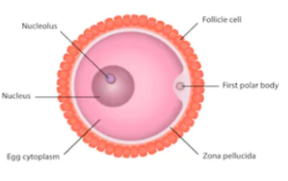
Draw a labeled diagram of human ovum released after ovulation.
Answer
501k+ views
Hint:
The process of release of ovum from the woman’s ovary is called ovulation. After the release of ovum from the ovary it travels from the fallopian tube, at this site the fertilization of egg by a sperm may occur. The process of ovulation occurs when the ovarian follicles rupture and release the oocytes which are secondary ovarian cells. Ovulation lasts for one day and occurs at the middle of the menstrual cycle in the woman. If the egg gets fertilized in the fallopian tube it passes into the uterus and implants with the wall of uterus to develop.
Complete answer:

Corona radiata are also referred to as follicular cells are the innermost layer of cells of cumulus oophorus and are placed adjacent to zona pellucida. Its most important function is to supply vital proteins to the cell. These cells are formed when granulosa cells enlarge and become cuboidal which occur from primary stage to primordial. Zona pellucida is a jelly coat in the ovum and also referred to as extracellular matrix present surrounding the developing oocyte. Zona pellucida helps in oocyte development, fertilization, prevent polyspermy, spermatozoa binding, preventing premature implantation and development of blastocyst. Nucleus of the ovum contains genetic material of the female which determines the trait of the child. Cortical granules are secretory organelles which help in prevention of polyspermy after the fertilization of the ovum.
Note: Ovum and sperm fertilize to make zygote and both contain the genetic material of both the parents and the traits of the child is dependent upon the genetic material of both the parents as the zygote attains dominant alleles from both the parents.
The process of release of ovum from the woman’s ovary is called ovulation. After the release of ovum from the ovary it travels from the fallopian tube, at this site the fertilization of egg by a sperm may occur. The process of ovulation occurs when the ovarian follicles rupture and release the oocytes which are secondary ovarian cells. Ovulation lasts for one day and occurs at the middle of the menstrual cycle in the woman. If the egg gets fertilized in the fallopian tube it passes into the uterus and implants with the wall of uterus to develop.
Complete answer:

Corona radiata are also referred to as follicular cells are the innermost layer of cells of cumulus oophorus and are placed adjacent to zona pellucida. Its most important function is to supply vital proteins to the cell. These cells are formed when granulosa cells enlarge and become cuboidal which occur from primary stage to primordial. Zona pellucida is a jelly coat in the ovum and also referred to as extracellular matrix present surrounding the developing oocyte. Zona pellucida helps in oocyte development, fertilization, prevent polyspermy, spermatozoa binding, preventing premature implantation and development of blastocyst. Nucleus of the ovum contains genetic material of the female which determines the trait of the child. Cortical granules are secretory organelles which help in prevention of polyspermy after the fertilization of the ovum.
Note: Ovum and sperm fertilize to make zygote and both contain the genetic material of both the parents and the traits of the child is dependent upon the genetic material of both the parents as the zygote attains dominant alleles from both the parents.
Latest Vedantu courses for you
Grade 11 Science PCM | CBSE | SCHOOL | English
CBSE (2025-26)
School Full course for CBSE students
₹41,848 per year
Recently Updated Pages
Basicity of sulphurous acid and sulphuric acid are

Master Class 12 Economics: Engaging Questions & Answers for Success

Master Class 12 Maths: Engaging Questions & Answers for Success

Master Class 12 Biology: Engaging Questions & Answers for Success

Master Class 12 Physics: Engaging Questions & Answers for Success

Master Class 4 Maths: Engaging Questions & Answers for Success

Trending doubts
Give 10 examples of unisexual and bisexual flowers

Draw a labelled sketch of the human eye class 12 physics CBSE

a Tabulate the differences in the characteristics of class 12 chemistry CBSE

Differentiate between homogeneous and heterogeneous class 12 chemistry CBSE

Why is the cell called the structural and functional class 12 biology CBSE

Differentiate between insitu conservation and exsitu class 12 biology CBSE




